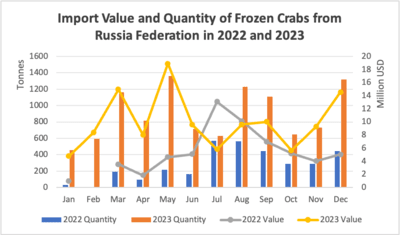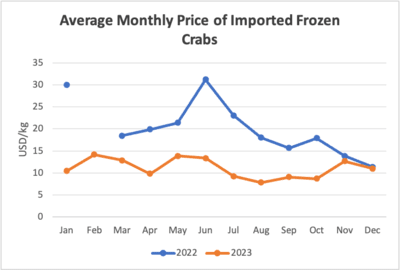China's crab imports from the Russian Federation experience significant surge
.png?sfvrsn=7f6ae663_1)
With the United States of America and European Union imposing a ban on Russian seafood exports, the Chinese market has emerged as the most crucial destination for Russian crab products. According to statistics from the General Administration of Customs of the People's Republic of China, both live, fresh or chilled and frozen crab exports from the Russian Federation to China have witnessed significant growth. Overall, compared to 2022, China's import quantity of crab from the Russian Federation has increased by 74.8 percent, with the import value rising by 42.5 percent.
Breaking down the imported goods, China's imports of live, fresh or chilled crabs from the Russian Federation have surged from 20,090.4 tonnes in 2022 to 30,104.6 tonnes in 2023, marking an approximate 49.8 percent increase. The import value has risen from USD 709,788,936 in 2022 to USD 978,236,942 in 2023, representing a growth of around 37.82 percent. Monthly import value and quantity of live, fresh or chilled crabs are demonstrated in Figure 1.
The import quantity of frozen crab has surged from 3 300.6 tonnes in 2022 to 10 773.6 tonnes in 2023, indicating an impressive growth of approximately 226.4 percent. The import value for frozen crab has risen from USD 60 597,059 in 2022 to USD 119 514 444 in 2023, showcasing an increase of around 97.23 percent. Monthly import value and quantity frozen crabs are demonstrated in Figure 1.
The increase in imports is closely tied to the robust market demand in the Chinese market. According to the data from Shanghai Changxing Island Fishing Port, last year, Hengsha Fishing Port on Changxing Island received a total of 31 foreign fishing vessels for unloading, marking a 520 percent increase compared to 2022. The total import volume of live seafood increased by 430 percent year-on-year, which is primarily driven by Russian crabs. Russian king crabs shipped by sea can reach Shanghai within three days after harvesting, with a high survival rate of crabs. As Hengsha Fishing Port continues to supply more salmon, tuna, and crabs to the thriving restaurants and markets in Shanghai, the seafood trade at Hengsha Fishing Port is expected to continue growing.
In terms of prices, despite the substantial increase in import volume, the average price of imported crab products in 2023 is lower compared to 2022. Detailed average monthly price trends are demonstrated in Figure 3 and Figure 4. The decline may be attributed to the economic sanctions affecting Russian seafood exports, leading to a surplus of supply seeking corresponding market demand.

Figure 1 Import Value and Quantity of Live, Fresh or Chilled Crabs from Russia Federation in 2022 and 2023

Figure 2 Import Value and Quantity of Fresh or Chilled Crabs from Russia Federation in 2022 and 2023

Figure 3 Average Monthly Price of Imported Live, Fresh or Chilled Crabs from Russia Federation in 2022 and 2023

Figure 4 Average Monthly Price of Imported Frozen Crabs from Russia Federation in 2022 and 2023
